[English] 日本語
 Yorodumi
Yorodumi- PDB-7nrx: Straight filament from Alzheimer's disease with PET ligand APN-1607 -
+ Open data
Open data
- Basic information
Basic information
| Entry | Database: PDB / ID: 7nrx | |||||||||||||||||||||
|---|---|---|---|---|---|---|---|---|---|---|---|---|---|---|---|---|---|---|---|---|---|---|
| Title | Straight filament from Alzheimer's disease with PET ligand APN-1607 | |||||||||||||||||||||
 Components Components | Microtubule-associated protein tau | |||||||||||||||||||||
 Keywords Keywords | PROTEIN FIBRIL / Tau filament / Positron emission tomography | |||||||||||||||||||||
| Function / homology |  Function and homology information Function and homology informationplus-end-directed organelle transport along microtubule / histone-dependent DNA binding / negative regulation of establishment of protein localization to mitochondrion / neurofibrillary tangle / microtubule lateral binding / axonal transport / tubulin complex / positive regulation of protein localization to synapse / negative regulation of tubulin deacetylation / phosphatidylinositol bisphosphate binding ...plus-end-directed organelle transport along microtubule / histone-dependent DNA binding / negative regulation of establishment of protein localization to mitochondrion / neurofibrillary tangle / microtubule lateral binding / axonal transport / tubulin complex / positive regulation of protein localization to synapse / negative regulation of tubulin deacetylation / phosphatidylinositol bisphosphate binding / generation of neurons / rRNA metabolic process / axonal transport of mitochondrion / regulation of mitochondrial fission / axon development / regulation of chromosome organization / central nervous system neuron development / intracellular distribution of mitochondria / minor groove of adenine-thymine-rich DNA binding / lipoprotein particle binding / microtubule polymerization / negative regulation of mitochondrial membrane potential / dynactin binding / regulation of microtubule polymerization / apolipoprotein binding / main axon / protein polymerization / axolemma / glial cell projection / Caspase-mediated cleavage of cytoskeletal proteins / regulation of microtubule polymerization or depolymerization / negative regulation of mitochondrial fission / neurofibrillary tangle assembly / positive regulation of axon extension / regulation of cellular response to heat / Activation of AMPK downstream of NMDARs / synapse assembly / positive regulation of superoxide anion generation / regulation of long-term synaptic depression / positive regulation of protein localization / supramolecular fiber organization / cellular response to brain-derived neurotrophic factor stimulus / cytoplasmic microtubule organization / regulation of calcium-mediated signaling / positive regulation of microtubule polymerization / somatodendritic compartment / axon cytoplasm / astrocyte activation / stress granule assembly / phosphatidylinositol binding / nuclear periphery / regulation of microtubule cytoskeleton organization / protein phosphatase 2A binding / cellular response to reactive oxygen species / Hsp90 protein binding / microglial cell activation / cellular response to nerve growth factor stimulus / synapse organization / protein homooligomerization / PKR-mediated signaling / regulation of synaptic plasticity / SH3 domain binding / response to lead ion / microtubule cytoskeleton organization / memory / cytoplasmic ribonucleoprotein granule / neuron projection development / cell-cell signaling / single-stranded DNA binding / protein-folding chaperone binding / cellular response to heat / actin binding / microtubule cytoskeleton / cell body / growth cone / double-stranded DNA binding / protein-macromolecule adaptor activity / microtubule binding / dendritic spine / sequence-specific DNA binding / amyloid fibril formation / microtubule / learning or memory / neuron projection / regulation of autophagy / membrane raft / axon / negative regulation of gene expression / neuronal cell body / dendrite / DNA damage response / protein kinase binding / enzyme binding / mitochondrion / DNA binding / RNA binding / extracellular region / identical protein binding / nucleus / plasma membrane Similarity search - Function | |||||||||||||||||||||
| Biological species |  Homo sapiens (human) Homo sapiens (human) | |||||||||||||||||||||
| Method | ELECTRON MICROSCOPY / helical reconstruction / cryo EM / Resolution: 3.55 Å | |||||||||||||||||||||
 Authors Authors | Shi, Y. / Murzin, A.G. / Falcon, B. / Epstein, A. / Machin, J. / Tempest, P. / Newell, K.L. / Vidal, R. / Garringer, H.J. / Sahara, N. ...Shi, Y. / Murzin, A.G. / Falcon, B. / Epstein, A. / Machin, J. / Tempest, P. / Newell, K.L. / Vidal, R. / Garringer, H.J. / Sahara, N. / Higuchi, M. / Ghetti, B. / Jang, M. / Scheres, S.H.W. / Goedert, M. | |||||||||||||||||||||
| Funding support |  United Kingdom, European Union, United Kingdom, European Union,  United States, United States,  Japan, 6items Japan, 6items
| |||||||||||||||||||||
 Citation Citation |  Journal: Acta Neuropathol / Year: 2021 Journal: Acta Neuropathol / Year: 2021Title: Cryo-EM structures of tau filaments from Alzheimer's disease with PET ligand APN-1607. Authors: Yang Shi / Alexey G Murzin / Benjamin Falcon / Alexander Epstein / Jonathan Machin / Paul Tempest / Kathy L Newell / Ruben Vidal / Holly J Garringer / Naruhiko Sahara / Makoto Higuchi / ...Authors: Yang Shi / Alexey G Murzin / Benjamin Falcon / Alexander Epstein / Jonathan Machin / Paul Tempest / Kathy L Newell / Ruben Vidal / Holly J Garringer / Naruhiko Sahara / Makoto Higuchi / Bernardino Ghetti / Ming-Kuei Jang / Sjors H W Scheres / Michel Goedert /     Abstract: Tau and Aβ assemblies of Alzheimer's disease (AD) can be visualized in living subjects using positron emission tomography (PET). Tau assemblies comprise paired helical and straight filaments (PHFs ...Tau and Aβ assemblies of Alzheimer's disease (AD) can be visualized in living subjects using positron emission tomography (PET). Tau assemblies comprise paired helical and straight filaments (PHFs and SFs). APN-1607 (PM-PBB3) is a recently described PET ligand for AD and other tau proteinopathies. Since it is not known where in the tau folds PET ligands bind, we used electron cryo-microscopy (cryo-EM) to determine the binding sites of APN-1607 in the Alzheimer fold. We identified two major sites in the β-helix of PHFs and SFs and a third major site in the C-shaped cavity of SFs. In addition, we report that tau filaments from posterior cortical atrophy (PCA) and primary age-related tauopathy (PART) are identical to those from AD. In support, fluorescence labelling showed binding of APN-1607 to intraneuronal inclusions in AD, PART and PCA. Knowledge of the binding modes of APN-1607 to tau filaments may lead to the development of new ligands with increased specificity and binding activity. We show that cryo-EM can be used to identify the binding sites of small molecules in amyloid filaments. | |||||||||||||||||||||
| History |
|
- Structure visualization
Structure visualization
| Movie |
 Movie viewer Movie viewer |
|---|---|
| Structure viewer | Molecule:  Molmil Molmil Jmol/JSmol Jmol/JSmol |
- Downloads & links
Downloads & links
- Download
Download
| PDBx/mmCIF format |  7nrx.cif.gz 7nrx.cif.gz | 180.2 KB | Display |  PDBx/mmCIF format PDBx/mmCIF format |
|---|---|---|---|---|
| PDB format |  pdb7nrx.ent.gz pdb7nrx.ent.gz | 120.9 KB | Display |  PDB format PDB format |
| PDBx/mmJSON format |  7nrx.json.gz 7nrx.json.gz | Tree view |  PDBx/mmJSON format PDBx/mmJSON format | |
| Others |  Other downloads Other downloads |
-Validation report
| Summary document |  7nrx_validation.pdf.gz 7nrx_validation.pdf.gz | 1.3 MB | Display |  wwPDB validaton report wwPDB validaton report |
|---|---|---|---|---|
| Full document |  7nrx_full_validation.pdf.gz 7nrx_full_validation.pdf.gz | 1.3 MB | Display | |
| Data in XML |  7nrx_validation.xml.gz 7nrx_validation.xml.gz | 35.6 KB | Display | |
| Data in CIF |  7nrx_validation.cif.gz 7nrx_validation.cif.gz | 49.5 KB | Display | |
| Arichive directory |  https://data.pdbj.org/pub/pdb/validation_reports/nr/7nrx https://data.pdbj.org/pub/pdb/validation_reports/nr/7nrx ftp://data.pdbj.org/pub/pdb/validation_reports/nr/7nrx ftp://data.pdbj.org/pub/pdb/validation_reports/nr/7nrx | HTTPS FTP |
-Related structure data
| Related structure data |  12552MC  7nrqC  7nrsC  7nrtC  7nrvC M: map data used to model this data C: citing same article ( |
|---|---|
| Similar structure data |
- Links
Links
- Assembly
Assembly
| Deposited unit | 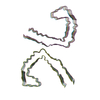
|
|---|---|
| 1 | 
|
| 2 | 
|
- Components
Components
| #1: Protein | Mass: 45919.871 Da / Num. of mol.: 10 / Source method: isolated from a natural source / Source: (natural)  Homo sapiens (human) / References: UniProt: P10636 Homo sapiens (human) / References: UniProt: P10636 |
|---|
-Experimental details
-Experiment
| Experiment | Method: ELECTRON MICROSCOPY |
|---|---|
| EM experiment | Aggregation state: FILAMENT / 3D reconstruction method: helical reconstruction |
- Sample preparation
Sample preparation
| Component | Name: Sarkosyl-insoluble fractions from Alzheimer's disease with PET ligand APN-1607 Type: TISSUE / Entity ID: all / Source: NATURAL |
|---|---|
| Source (natural) | Organism:  Homo sapiens (human) Homo sapiens (human) |
| Buffer solution | pH: 7.5 |
| Specimen | Embedding applied: NO / Shadowing applied: NO / Staining applied: NO / Vitrification applied: YES |
| Vitrification | Cryogen name: ETHANE |
- Electron microscopy imaging
Electron microscopy imaging
| Experimental equipment |  Model: Titan Krios / Image courtesy: FEI Company |
|---|---|
| Microscopy | Model: FEI TITAN KRIOS |
| Electron gun | Electron source:  FIELD EMISSION GUN / Accelerating voltage: 300 kV / Illumination mode: FLOOD BEAM FIELD EMISSION GUN / Accelerating voltage: 300 kV / Illumination mode: FLOOD BEAM |
| Electron lens | Mode: BRIGHT FIELD |
| Image recording | Electron dose: 50.6 e/Å2 / Detector mode: COUNTING / Film or detector model: GATAN K2 SUMMIT (4k x 4k) |
- Processing
Processing
| CTF correction | Type: PHASE FLIPPING AND AMPLITUDE CORRECTION |
|---|---|
| Helical symmerty | Angular rotation/subunit: -1.02 ° / Axial rise/subunit: 4.75 Å / Axial symmetry: C1 |
| 3D reconstruction | Resolution: 3.55 Å / Resolution method: FSC 0.143 CUT-OFF / Num. of particles: 20075 / Symmetry type: HELICAL |
 Movie
Movie Controller
Controller






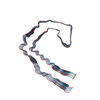



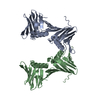
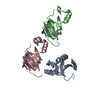

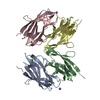
 PDBj
PDBj





